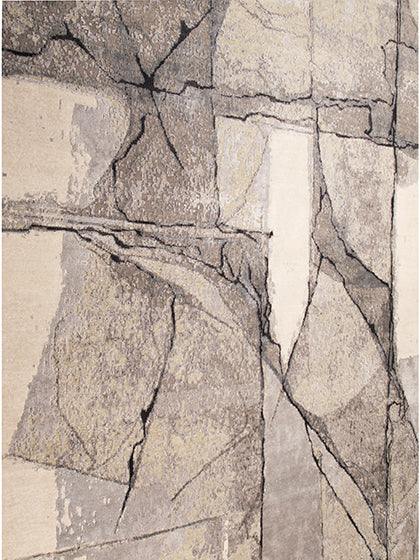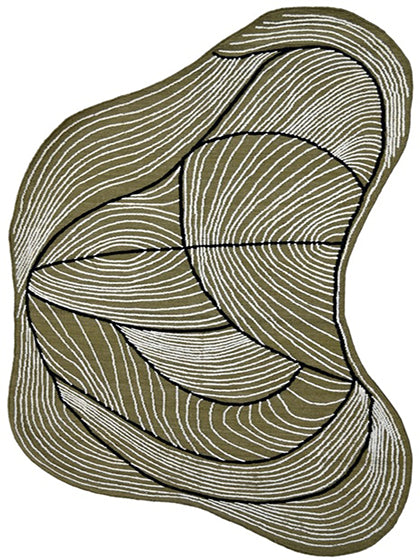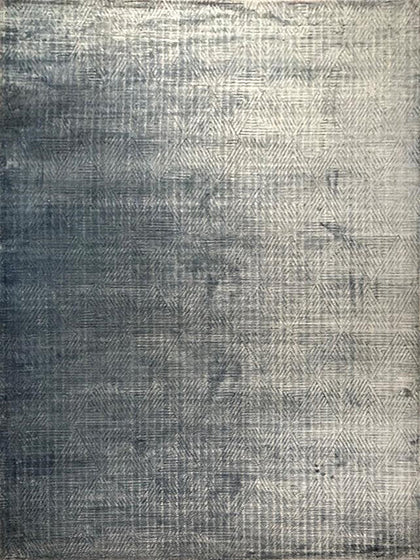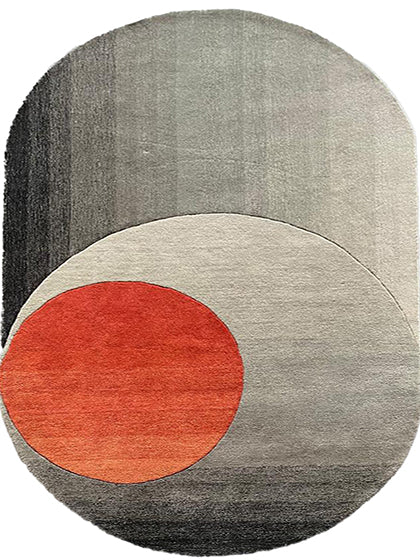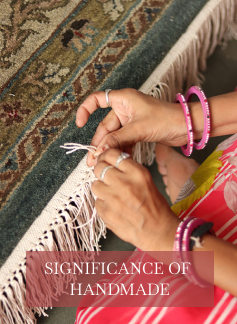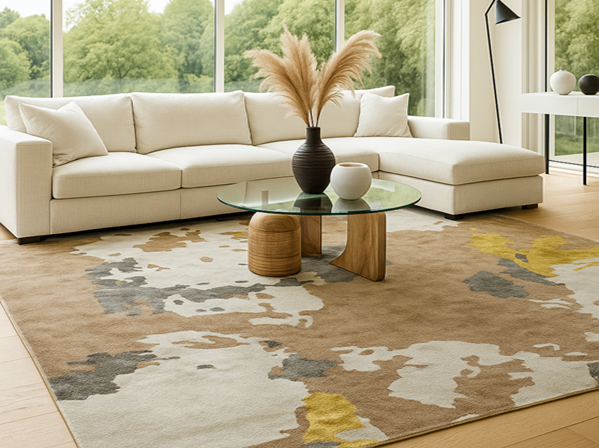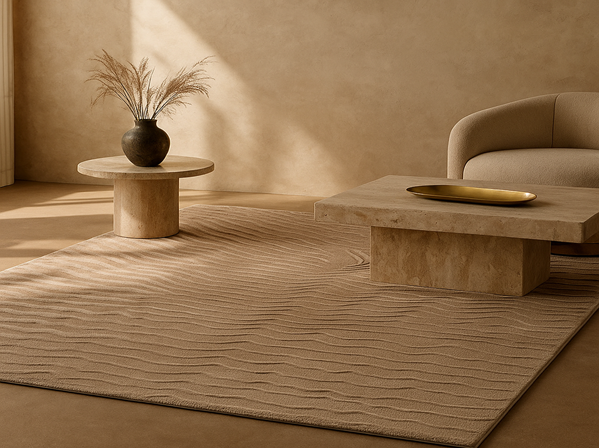Exploring value, craft, trends and what this means for luxury handmade rug brands
In an era where affordability, speed-to-market and mass-manufacturing are increasingly dominant in home-furnishing, one question rises: Will cheaper machine-made rugs ultimately replace handmade rugs? For a premium brand like Carpet Couture by Rashi (which specialises in luxury handmade carpets and custom shapes/sizes), this is a highly relevant question. The short answer: no — at least not entirely — but the dynamics are shifting and need to be understood.
1. Current Market Snapshot: Machine-Made vs Handmade
-
Globally, machine-made (or mechanically produced) area rugs currently account for around 60% of the market by weave type, thanks to their cost-effectiveness and production scale.
-
Yet the handmade area-rug segment is projected to grow at the fastest CAGR (~7.1%) from 2024-2030.
-
Market size for rugs and carpets continues to expand: one report shows the global rugs & carpets market valued at USD 58.93 billion in 2024, projected to grow to USD 133.94 billion by 2032.
-
A recent blog emphasises that machine-made rugs may offer affordability but often lack the long-term durability, craftsmanship and investment value of handmade rugs.
What these facts show: while machine-made rugs dominate in volume and affordability, the handmade segment still holds strong — and perhaps even growing — premium value. So blanket replacement is unlikely, but competition is real.
2. Why Machine-Made Rugs are Gaining Ground
Several factors are driving the rise of machine-made rugs:
-
Cost and affordability: Machines, synthetic fibres, economies of scale allow much lower price-points. For consumers on budget, machine-made is attractive.
-
Speed and availability: Machine production is faster; wider choices of colours/designs; ready stock rather than long lead-times.
-
Uniformity and design variation: Machine techniques now allow quite intricate designs at scale, plus repeatable quality, making them suitable for mass projects, commercial spaces, rental homes.
-
E-commerce and scale distribution: Online platforms make it easy to buy affordable machine-made rugs globally.
-
High traffic/lower cost use-cases: In commercial, high-traffic or short-life spaces (e.g., rental flats, offices) the economics favour machine-made.
For brands like Carpet Couture by Rashi, this means the “entry-level” or “budget design” segment is increasingly saturated with machine-made alternatives.
3. Why Handmade Rugs Retain Their Place — and Why They Won’t Disappear
Despite the rise of machine-made rugs, handmade rugs continue to hold unique advantages — and here’s why they won’t be replaced completely:
-
Artisan craftsmanship & uniqueness: Handmade rugs involve skilled artisans, hand-knotted or hand-tufted techniques, natural materials, variations that create value.
-
Durability & longevity: A well-crafted handmade rug can last for decades (sometimes a lifetime), becoming heirloom pieces; machine-made ones tend to depreciate faster.
-
Material quality & tactile luxury: Handmade often uses wool, silk, bamboo-silk, etc., giving luxury feel and sometimes sustainable credentials.
-
Emotional & design appeal: For clients and designers seeking bespoke, high-end, unique design, handmade offers a narrative and exclusivity.
-
Investment value / resale potential: Handmade rugs can retain or appreciate value; machine-made rarely do.
-
Customization & premium spaces: Markets like luxury residences, hospitality, boutique hotels still value the bespoke nature of handmade. For example, shaped rugs, unusual colourways, large formats — where machine production may be limited in flexibility.
Hence, handmade rugs remain a distinct segment that offers differentiation from mass-market machine-made goods.
4. Key Tensions & Realities for the Handmade Segment
For a brand like Carpet Couture by Rashi, being positioned in the handmade luxury sphere, these are the realities to contend with:
-
Price sensitivity: As machine-made prices drop, clients might question the premium for handmade. The brand narrative must reinforce the value (materials, craftsmanship, longevity, customisation).
-
Lead-time & production constraints: Handmade production takes time; clients used to rapid delivery may push for shorter turnarounds.
-
Quality standards & transparency: Handmade needs to consistently deliver in material, knot density, finish — else clients may see it as “just expensive machine-made”. Educating buyers is key.
-
Consumer awareness & education: Many consumers may not understand the difference between machine vs handmade; brands must clarify why handcrafted matters.
-
Sustainability & authenticity: Handmade often aligns with eco / sustainable / artisan values — which can be leveraged, especially among discerning buyers.
-
Scale & growth pressures: As demand for custom handmade grows (especially in hospitality/luxury segments), maintaining quality while scaling is a challenge.
5. So — Will Machine-Made Replace Handmade? Here’s the Verdict
-
Short answer: No — Handmade rugs will not be fully replaced by cheaper machine-made rugs. They occupy different segments, value propositions and buyer motivations.
-
Machine-made will continue to dominate the volume and budget space, especially for mass-market, commercial, rental, high-traffic uses.
-
Handmade will persist and possibly grow in the premium segments, especially where quality, uniqueness, brand story, material and customisation matter. The market data supports growth in the handmade segment.
-
The competition is real, and handmade brands must sharpen their value proposition, storytelling, design differentiation and service (custom size/shape, luxury materials, bespoke options) to maintain edge.
-
Hybrid models may emerge: For example, machine-made pieces mimicking hand-loom look, lower-cost artisanal blends, or “entry handmade” lines that reduce cost while retaining essential handcrafted features. Handmade brands might also incorporate machine-aided processes for partial cost savings while preserving the artisan touch.
6. What This Means for Carpet Couture by Rashi
As a brand focused on bespoke handmade rugs, you can use this dynamic to your advantage:
-
Emphasise your unique selling points: custom sizing/shapes, premium natural materials (wool, silk, bamboo-silk, nettle yarn), hand-knotted or hand-tufted artisan work, story behind production, alignment with Indian artisan heritage.
-
Educate your audience: Provide content (blogs, social posts) explaining why handmade is a better long-term value, why materials and knotting matter, show behind-the-scenes, artisan profiles.
-
Segment your offering: Offer entry-luxury handmade (smaller size, simpler design) vs ultra-premium (large format, shaped, custom colour). This allows clients to enter the handmade space at lower cost while seeing your craftsmanship.
-
Target luxury & hospitality clients: These segments appreciate custom, craftsmanship, story and are less price-sensitive. You already have opportunity in hospitality/hotel/resort verticals.
-
Build longevity & investment narrative: Frame your handmade rugs as investments, assets that age beautifully, not disposable décor.
-
Stay design-forward: Offer trending colours, shapes, textures and abstract patterns while retaining authenticity. This ensures your handmade pieces stay relevant vs machine-made’s faster trend churn.

